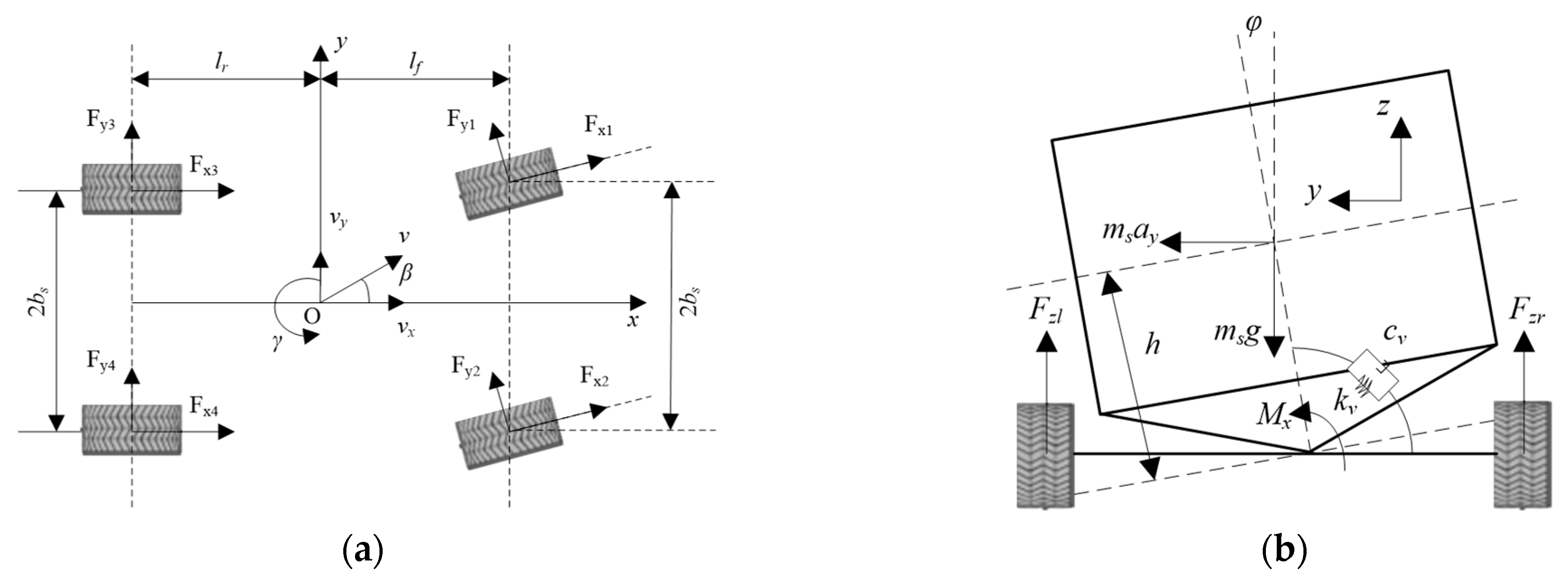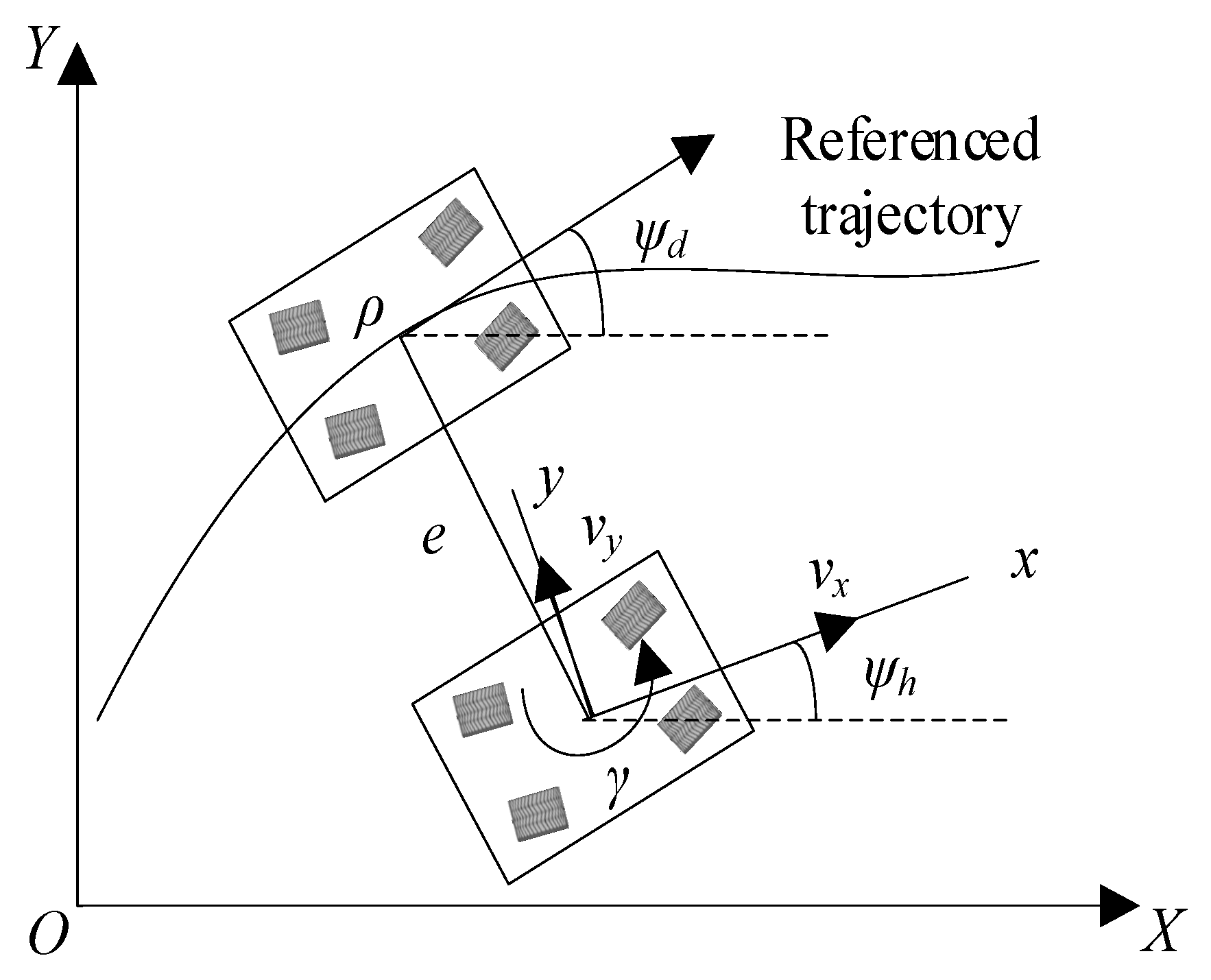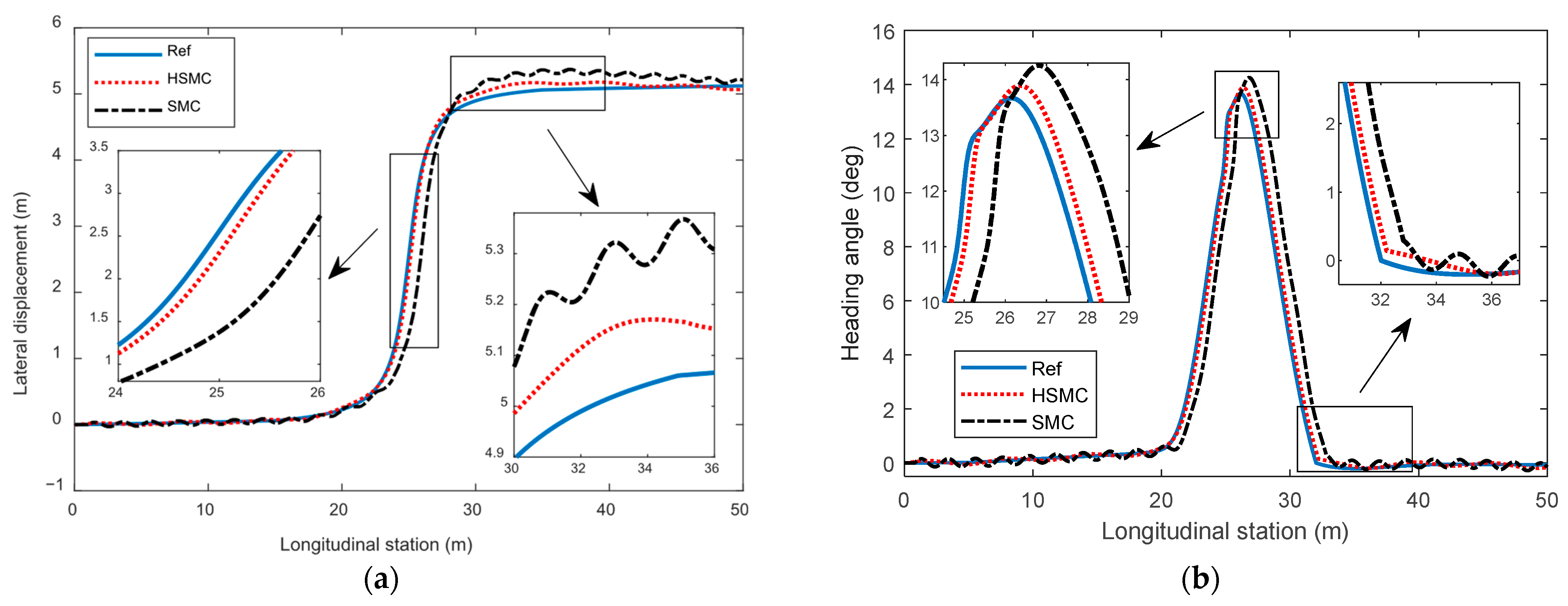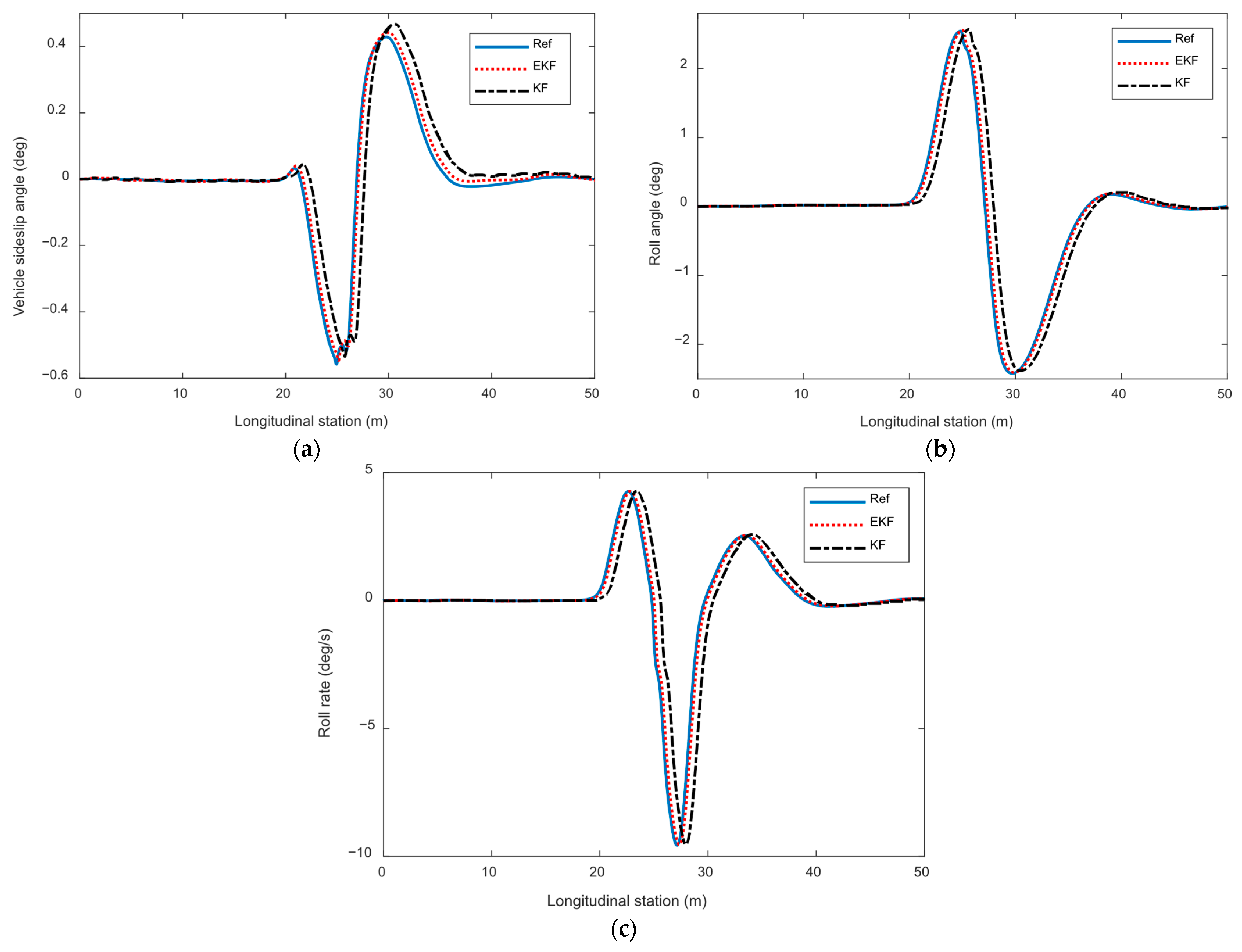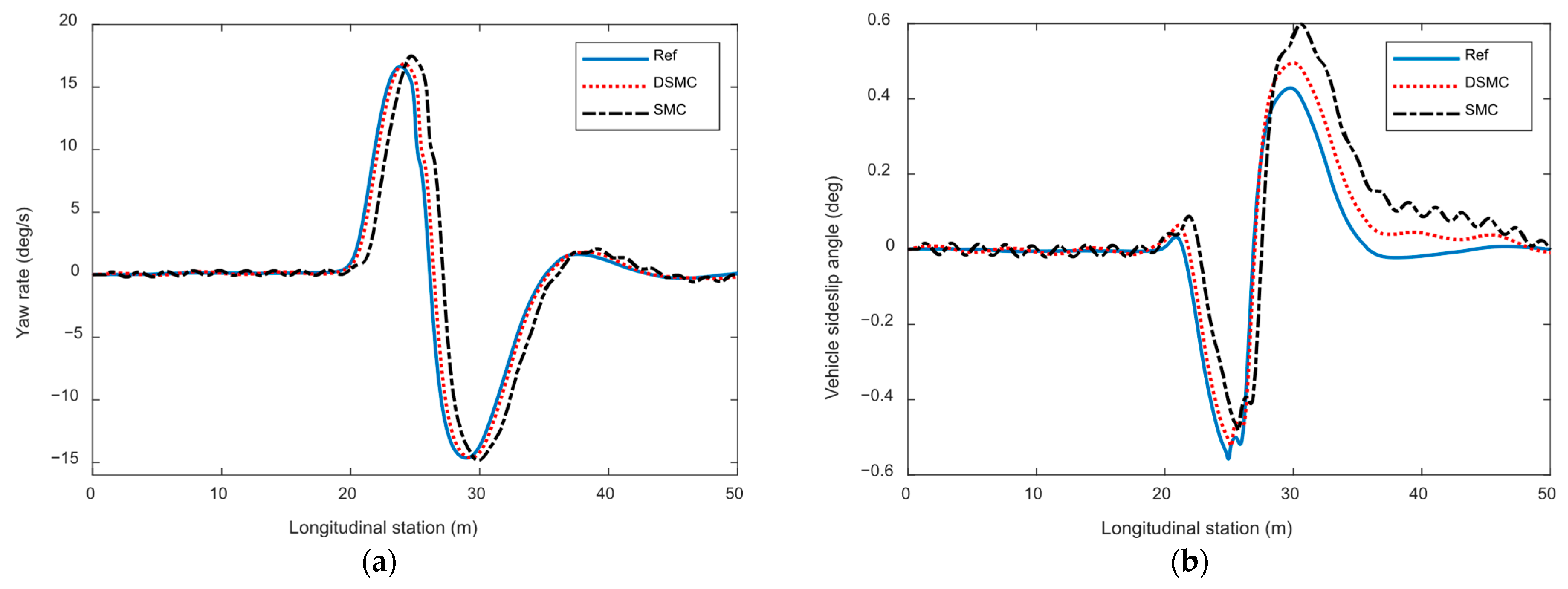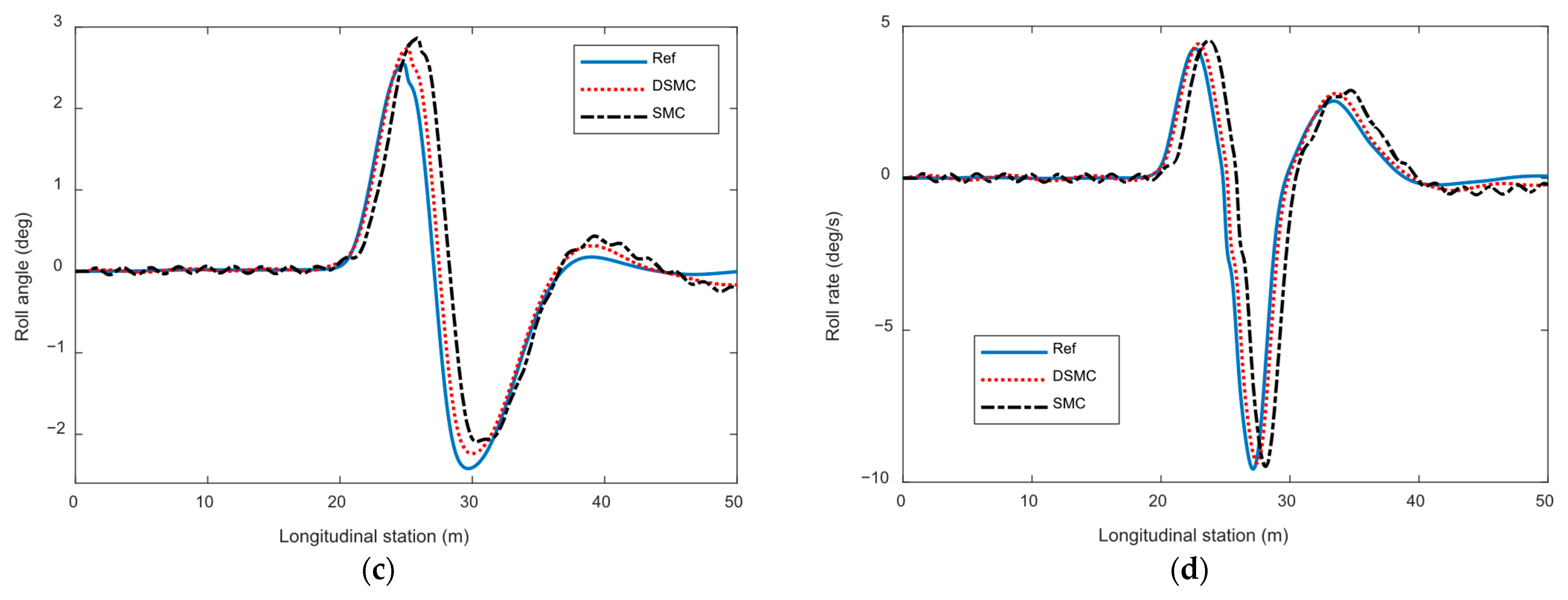1. Introduction
With the rapid development of intelligent networking and autonomous driving technologies, trajectory-tracking accuracy and vehicle stability have become two core indicators that determine the safety and comfort of high-order auto-drive systems [
1,
2]. In recent years, trajectory-tracking strategies based on model predictive control, robust control, and artificial intelligence algorithms have made significant progress in structured road scenes, achieving centimeter-level tracking accuracy at moderate vehicle speeds and good road adhesion conditions [
3,
4]. However, when the vehicle is in extreme conditions such as high-speed lane changing, emergency obstacle avoidance, or low-adhesion conditions, the trajectory-tracking performance often deteriorates sharply due to tire force saturation, nonlinear roll–lateral coupling, and model uncertainty [
5,
6]. Existing research mostly focuses on path following at the lateral dynamics level, lacking systematic modeling and compensation for complex factors such as coupled vertical–lateral dynamics, interactions between spring and spring masses, and actuator dynamic hysteresis, resulting in response lag, overshoot, and even instability of control algorithms in practical deployment [
7,
8,
9].
Concurrently, vehicle stability control technology has also undergone an evolution from traditional single control to integrated chassis coordinated control. Although stability controllers based on lateral moment allocation can effectively suppress excessive or insufficient steering, their control logic is mostly independent of the trajectory-tracking layer, thereby exhibiting conflicting control objectives and redundant resource allocation [
10]. In recent years, collaborative control frameworks have been proposed with a multi-level objective of unified planning, tracking, and stability. However, existing collaborative methods often assume that the vehicle state can be measured in all dimensions and simplify roll dynamics as static or linear constraints, ignoring the coupling effect of roll angle on tire roll characteristics and load transfer [
11]. In particular, for vehicles with a high center of gravity such as SUVs and electric buses, lateral acceleration induced roll motion can significantly alter the vertical load distribution of tires, thereby weakening trajectory-tracking accuracy and inducing rollover risk. Establishing a real-time coupling mechanism between trajectory tracking and stability control has become a major bottleneck in current research [
12,
13].
On a technical level, limited state measurability is also a key challenge that hinders the performance of collaborative control [
14,
15]. The key state variables such as the center-of-mass lateral angle, roll angle, and angular velocity are difficult to obtain online at low cost and high accuracy. Traditional Kalman filtering exhibits inadequate estimation accuracy in strongly nonlinear and noise-coupled scenarios, leading to a decrease in the adaptability of the controller to extreme working conditions [
16,
17]. Furthermore, a fundamental trade-off exists between mitigating chattering and maintaining robustness in current sliding mode control approaches. Low-order sliding surfaces are easy to implement but exhibit significant chattering, while high-order sliding surfaces can suppress chattering but introduce complex high-order derivative calculations, making it difficult to balance real-time performance and engineering feasibility [
18,
19,
20].
With the evolution of intelligent driving systems towards the levels of L3 and above, the coordinated control of trajectory tracking and stability of vehicles under extreme conditions such as high speed, low adhesion, or emergency obstacle avoidance has become one of the core bottlenecks restricting their commercial implementation. Typical scenarios such as high-speed lane changing and obstacle avoidance exhibit high lateral acceleration, significant roll motion, and pronounced nonlinear coupling characteristics [
21,
22]. Traditional hierarchical architectures based on linear quadratic or model predictive control struggle to balance real-time performance and robustness; at the same time, key states such as center-of-mass lateral angle and roll angle are difficult to measure directly due to cost and installation limitations, further limiting the engineering application of advanced algorithms [
23,
24].
Sliding mode control (SMC) has been extensively applied in vehicle yaw and roll stability control in recent years, owing to its inherent robustness against parameter perturbations and external disturbances. However, conventional first-order SMC relies on high-frequency switching, resulting in actuator chattering, tire force saturation, and deterioration of ride comfort, especially under high-speed lane-changing conditions [
25,
26]. Trajectory-tracking errors and vehicle-state oscillations are coupled with each other, forming positive feedback in error disturbance, seriously weakening system performance. To reduce chattering, high-order sliding mode control (HSMC) achieves control signal continuity by embedding discontinuous terms into high-order derivatives, but its dependence on model accuracy and state information integrity significantly increases. Alternatively, nonlinear observers such as extended Kalman Filter (EKF) have been introduced to estimate unmeasurable states. Nevertheless, in the presence of strong lateral-roll coupling and large disturbance conditions, they still face problems such as accumulated linearization errors and insufficient convergence speed [
27,
28].
In addition, existing research often dissociates trajectory tracking from stability control: the trajectory-tracking layer assumes that the vehicle is always in the stable domain, while the stability control layer passively compensates for the instability trend caused by tracking errors [
29,
30]. Such a cascading structure, characterized by “tracking first, stabilizing later,” overlooks the dynamic interdependence between the two, leading to conflicts between internal and external objectives and hindering the achievement of global optimality. In recent years, some scholars have attempted to use integrated control frameworks to achieve integrated design of trajectory tracking and stability through shared state feedback or collaborative optimization of objective functions. However, achieving a balance between estimation accuracy, control robustness, and chattering suppression under real-time constraints remains a critical challenge. In summary, current trajectory-tracking and stability control research still faces multiple challenges in terms of model accuracy, state estimation, control algorithms, and hierarchical coordination [
31,
32]. How to construct a high-fidelity dynamic model that takes into account lateral vertical coupling, how to design a highly robust state estimator under uncertainty and measurement constraints, and how to construct a collaborative control framework with low vibration, strong robustness, and real-time deployment have become key scientific issues in promoting the landing of high-order autonomous driving.
High-speed lane changing of vehicles represent a typical strong-coupling, underactuated, and nonlinear extreme condition. Traditional layered control strategies commonly decouple trajectory tracking from stability control, resulting in dynamic interaction conflicts between the inner and outer loops, which may lead to trajectory lag, lateral/lateral oscillation, and even instability. In addition, it is difficult to directly measure key states such as the center of mass sideslip angle and roll angle at low cost and high precision during high dynamic processes, which further limits the engineering implementation of advanced control algorithms. SMC has been widely adopted in vehicle motion control due to its strong robustness, but the inherent chattering problem of first-order switching laws severely restricts its application in high-precision trajectory tracking and comfort requirements scenarios. In response to the above challenges, this article constructs a coupled dynamic model of lateral sway lateral tilt from the perspective of model estimation control integration, uses EKF to achieve soft sensing of unmeasurable states, and designs HSMC and double-power convergence law sliding-mode controller (DSMC) separately to achieve coordinated optimization of trajectory tracking and stability, providing a new technical approach for safe and reliable driving of autonomous vehicles under extreme conditions.
The structure of the rest of full text is as follows:
Section 2 elaborates on the dynamics model of intelligent vehicle;
Section 3 proposes a coordinated control strategy of trajectory tracking and vehicle stability based on state estimation;
Section 4 verifies the effectiveness of the observer-based coordinated control strategy of trajectory tracking and lateral-roll stability;
Section 5 summarizes the research results.
4. Result Verification
In order to verify the application effect of the state-estimation-based vehicle trajectory tracking and stability collaborative control strategy designed in the article, simulation verification and analysis were conducted based on a joint simulation model of CarSim V8.02 and Simulink R2022b. Among them, the CarSim software was used to provide a dynamic model of the entire vehicle, and the vehicle-state estimation module and vehicle-coupling control module were built in Simulink software. Corresponding simulation conditions were selected for joint simulation experiments. The vehicle parameters in the simulation are shown in
Table 1. In addition, the simulation test conditions are selected for lane-changing scenarios with a vehicle speed of 20 m/s and a road adhesion coefficient of 1.0.
In order to reflect the vehicle application effect of the proposed sliding-mode-control algorithm, a common conventional sliding-mode-control algorithm based on switching control law is selected as the comparison benchmark. Under driving conditions involving lane-changing trajectory-tracking control, the obtained vehicle trajectory-tracking control results are shown in
Figure 4. According to the actual vehicle travel trajectory results under different control methods, it can be seen that the vehicle travel trajectory obtained under the HSMC algorithm is significantly closer to the reference trajectory overall. While the conventional sliding-mode-control algorithm can track the general trend of the reference trajectory, it suffers from notable lag and deviation, particularly during rapid lane-changing maneuvers. Through the local magnification of the trajectory curve, it can be observed that the vehicle trajectory under the HSMC algorithm has faster response capability and higher tracking accuracy during rapid lane changes. Compared to the sliding-mode-control algorithm, the overall vehicle trajectory curve has a very minor time-delay problem. At the same time, when the vehicle changes lanes and needs to return to straight driving, the trajectory curve obtained by the conventional SMC algorithm exhibits significant oscillations and fluctuations, which are caused by the inherent chattering problem of the sliding-mode-control algorithm and switching control law. In contrast, the proposed HSMC algorithm can make the vehicle’s driving trajectory smoother and converge faster.
The trend of changes in vehicle heading angle can better reflect the changes in the direction of vehicle travel. According to the comparison results of vehicle heading angles in
Figure 4, it can also be observed that there is a certain degree of lag in the tracking reference value of the vehicle heading angle under sliding-mode control, which is the direct reason for the lag of the vehicle driving trajectory curve compared to the reference trajectory curve under this algorithm. In contrast, the proposed high-order sliding-mode-control algorithm can ensure that the vehicle heading change can timely track the change requirements of the reference heading angle. Through local magnification, it can be seen that under the SMC algorithm, there is still a certain degree of fluctuation and oscillation in the amplitude of the vehicle heading angle after the vehicle trajectory returns to normal, which is also the direct reason for the oscillation of the vehicle’s driving trajectory at this time. The vehicle driving trajectory under the HSMC algorithm can track the trend of the reference heading angle in real time and accurately, and the overall tracking accuracy and dynamic response capability have been significantly improved.
The lateral deviation and heading deviation in the process of vehicle trajectory-tracking control can more intuitively reflect the trajectory-tracking accuracy under different control methods. Therefore, the error results of vehicle trajectory-tracking control were statistically analyzed, as shown in
Figure 5. During the period when the vehicle is driving in a straight line and has not changed lanes, the lateral deviation of the vehicle under the two control methods is basically the same and fluctuates around zero values. When the vehicle changes lanes quickly, the lateral deviation of trajectory tracking under SMC algorithm increases sharply and the maximum amplitude is close to 1.5 m. In contrast, the lateral deviation of trajectory tracking under HSMC algorithm is well suppressed, with a maximum value of about 0.25 m, which is significantly reduced compared to SMC. At the same time, when the vehicle changes lanes and needs to continue driving in a straight line, the lateral deviation of the vehicle trajectory under the HSMC algorithm can quickly and smoothly converge and eventually approach zero. Under the SMC algorithm, there is a certain degree of overshoot in the lateral deviation of vehicle trajectories, which decreases to zero at the maximum amplitude and then increases in the opposite direction. Subsequently, its amplitude convergence speed is significantly slower and there is a significant oscillation phenomenon. This indicates that SMC algorithm is inferior to HSMC in terms of dynamic adjustment response capability and tracking accuracy.
The deviation in vehicle trajectory-tracking heading also shows the same trend of change. According to the comparison of heading deviation, it can be seen that during the period when the vehicle is traveling in a straight line and has not changed lanes, the heading angle of the vehicle under the two control algorithms remains basically unchanged around zero. When the vehicle needs to change lanes, the heading deviation of the vehicle under the HSMC algorithm is relatively small and its maximum deviation amplitude is about 1 deg, indicating that the heading of the vehicle under the HSMC algorithm is close to the reference trajectory requirement, thus ensuring good trajectory-tracking performance. In contrast, the vehicle trajectory heading deviation under the SMC algorithm increases rapidly in the initial stage of lane changing and reaches a deviation of nearly 3 deg. Then, during the process of the vehicle trajectory returning to normal, the heading deviation of the vehicle trajectory under the SMC algorithm increases in the opposite direction, which is also the direct reason for the occurrence of control overshoot in the lateral deviation of the vehicle trajectory. At the same time, the fluctuation and oscillation of vehicle heading deviation under SMC algorithm are more obvious, which leads to the oscillation of vehicle driving trajectory. Overall, the HSMC algorithm can significantly improve the vehicle trajectory-tracking control effect compared to SMC by providing fast heading tracking control and precise trajectory error-tracking suppression.
While analyzing the effectiveness of vehicle trajectory-tracking control, it is necessary to simultaneously consider the stability control effect of the vehicle. At this point, the performance of vehicle-state estimation based on EKF is one of the important factors affecting the effectiveness of vehicle stability control. The comparative results of vehicle-state estimation are shown in
Figure 6. Overall, the Kalman filter algorithm can accurately calculate the vehicle’s center of mass roll angle, roll angle, and roll-angle velocity, and the estimated vehicle trajectory curve is in good agreement with the actual values. During the rapid lane-change process of vehicles, the vehicle state changes sharply, and there is a certain degree of time delay and amplitude deviation in the vehicle-state estimation results under the KF algorithm. On the other hand, EKF can relatively maintain good estimation performance, and the vehicle-state estimation results based on EKF algorithm have a certain degree of improvement in real-time performance, convergence speed, and overall estimation accuracy compared to KF. This indicates that the overall performance of the proposed estimation method can meet the requirements of vehicle control inputs.
During the lane-change process, the integrated stability control effect of vehicle lateral roll is shown in
Figure 7. In order to independently reflect the effects of different control algorithms and obtain reliable reference values, in the simulation test, a trajectory-tracking controller was first established only in the Simulink model and the required front-wheel steering angle for control was obtained. Input the obtained front-wheel steering angle into the CarSim model and use the stability control module built-in in the model to achieve the stability requirements of the vehicle. Collect the vehicle-state variables under lane-changing conditions and use them as reference values. In this way, the stability control effect of the vehicle after the intervention of the designed control algorithm can be effectively reflected. As shown in the figure, compared with DSMC, the vehicle yaw rate under SMC algorithm has the problem of tracking control lag, and the vehicle yaw rate under SMC algorithm exhibits a certain degree of oscillation fluctuation. In contrast, the vehicle yaw rate curve under DSMC algorithm is smoother, which reflects that the introduced double-power convergence law can effectively improve the inherent oscillation problem of conventional SMC algorithm and switching control law. In the vehicle center of the mass lateral angle curve, the control results under DSMC algorithm are closer to the reference value, and its convergence speed and ability to suppress amplitude oscillations are more prominent. In contrast, under the SMC algorithm, the oscillation phenomenon of the vehicle’s center-of-mass sideslip angle curve is more obvious, with the maximum value of the center-of-mass sideslip angle approaching 0.4 degrees. The convergence speed of the state amplitude is slower, and the overall deviation degree of the amplitude is also greater. The control results of vehicle roll angle and roll-angle speed also showed the same trend. As shown in the figure, the vehicle’s roll angle and roll-angle speed also show a sharp increase and rapid fluctuation during lane changing and vehicle turning. At this point, there is a more significant lack of tracking capability and amplitude oscillation deviation in the tracking control results of SMC. In contrast, the vehicle-state curve under DSMC algorithm has higher smoothness, and the fluctuation amplitude of vehicle roll angle and roll-angle velocity is effectively suppressed, which helps to further improve vehicle stability. On the premise of theoretical analysis, combined with the simulation results, the designed control system has a stable equilibrium point, which ensures the gradual stability of the system control effect. The introduction of double-power convergence law makes the system have fast reaching characteristics when it is far from the equilibrium point, and can achieve smooth convergence when it is close to the equilibrium point. This property effectively solves the chattering problem of traditional sliding-mode control.
The high-speed core scenario of the strategy is locked in the typical high lateral excitation and high-speed coupling condition of “highway lane change emergency obstacle avoidance”, and its longitudinal speed range covers the daily high-speed cruise to the section close to the upper limit of vehicle dynamics. In this scenario, the comprehensive performance of trajectory-tracking accuracy and lateral roll stability needs to meet the criteria of “no significant delay and no visible oscillation”. When the vehicle can finish track tracking continuously and smoothly in the process of high-speed lane changing, and the roll motion and yaw response do not have secondary fluctuations that can be perceived by the driver and passengers, it can be determined that the strategy has sufficient conditions to serve as the engineering benchmark at the current hardware level. For extreme cases beyond the above scene boundary, the strategy will automatically switch to the safety degradation mode with “maintaining driving stability” as the priority, instead of continuing to pursue centimeter-level tracking accuracy.
In the process of control algorithm verification, the significance of quantitative statistical control error is that it can convert the qualitative judgment of performance into a comparable quantitative objective index, so as to provide a more accurate argument for the effectiveness of the algorithm. Through the statistics of the average error and root mean square error of key state variables such as lateral deviation, heading deviation and yaw rate, vehicle sideslip angle, roll angle and roll rate, the specific performance of the proposed control law in providing control effect can be further revealed. Then, the error average (
ea) and error root mean square (
er) can be denoted as
where
N is sampling amount,
denotes referenced value,
represents estimated value. The quantitative comparison results of
eAVE and
eRMSE are listed in
Table 2. From the overall comparative data, the proposed HSMC/DSMC control algorithm is superior to the traditional SMC in all six indicators, and the error reduction degree presents the hierarchical characteristics of significant lateral heading and moderate yaw roll. Specifically, in the two channels that directly affect the trajectory-tracking accuracy, lateral deviation, and heading error, the average value and root mean square of the error are significantly suppressed, indicating that the combination of high-order sliding-mode surface and double-power convergence law significantly weakens the trajectory lag and overshoot, and verifies the effectiveness of chattering suppression and finite-time convergence. In terms of the state variables related to stability, such as yaw rate, vehicle sideslip angle, roll angle and its angular velocity, the error is also reduced, but the amplitude is relatively mild, reflecting the trade-off between steady-state smoothness and dynamic response achieved by the lateral roll integrated control: it neither excessively inhibits the necessary yaw maneuver, but also effectively suppresses the roll oscillation. In summary, the collaborative strategy not only maintains the naturalness of vehicle motion, but also reduces the trajectory error and stability fluctuation, which provides a quantitative basis for pervasive control for most operating conditions.
5. Conclusions
(1) A lateral-roll coupling dynamic model and trajectory error model were established, and real-time accurate estimation of key unmeasurable states was achieved through EKF, solving the problems of difficult state acquisition and insufficient measurement accuracy in high dynamic processes.
(2) The proposed HSMC trajectory-tracking algorithm embeds the high-order derivatives of the sliding surface into the integral chain and uses virtual control variables to smooth the switching signal, fundamentally suppressing the chattering phenomenon of traditional sliding mode and ensuring that the system converges to the sliding-mode set within a finite time, significantly improving trajectory-tracking accuracy and ride comfort.
(3) The designed DSMC integrated lateral-roll controller is based on the double-power law of convergence, and adjusts the lateral and roll control torques online according to the estimated state, taking into account both fast convergence and steady-state smoothing requirements, achieving coordinated stable control of vehicle lateral-roll motion.
(4) Finally, based on the CarSim–Simulink joint simulation platform, the proposed strategy was validated in a high-speed lane-changing scenario with a vehicle speed of 20 m/s and a road adhesion coefficient of 1.0. The results show that compared with conventional sliding mode, HSMC reduces the maximum lateral deviation from 1.5 m to 0.25 m, reduces the peak heading deviation from 3 deg to within 1 deg, and has no visible chattering. Compared to standard Kalman filtering, EKF suppresses the delay in estimating results during state transitions. Under DSMC control, the oscillation amplitude of yaw rate and roll-angle velocity significantly decreases, and the overshoot of the center of mass roll angle is almost eliminated. The proposed method is significantly superior to traditional methods in terms of tracking accuracy, response speed, and stability, verifying the effectiveness and engineering feasibility of the method.
(5) In the future research work, the influence of parameter uncertainty, actuator saturation and complex road adhesion conditions on the control effect will be further considered from the perspective of model and algorithm. At the model level, it is planned to introduce the coupling term of nonlinear tire force model and aerodynamics, and dynamically correct the sideslip stiffness and wind load disturbance through the parameter online identification mechanism, so as to break through the working condition boundary of the current linear hypothesis; at the algorithm level, the high-order sliding mode and double-power sliding-mode framework are extended to a multi-stage adaptive structure. According to the road adhesion level and the vehicle state, the real-time switching gain is obtained, and the event trigger mechanism is introduced to reduce the computational load, so as to ensure the implement ability in the vehicle-embedded platform. In addition, for the problem of model mismatch and constraint coupling, the improved model predictive control can be studied. Through online linearization error correction and rolling time-domain adaptive weight, model predictive control can maintain the advantages of explicit constraint processing and reduce the dependence on accurate models; its output will form a two-tier architecture with the sliding-mode controller. The upper-model predictive control is responsible for global trajectory planning and constraint feasible region determination. The lower sliding mode can quickly compensate the model error and external disturbance to realize the complementarity of calculation accuracy and real-time performance. Secondly, for high-dimensional nonlinear dynamics and unknown disturbance scenarios, the deep reinforcement learning method will be explored and the end-to-end control strategy will be learned online; at the same time, a secure filter layer is designed to limit the reinforcement learning output to the attraction region of the sliding-mode surface, ensuring that the stability constraint can be met at the initial stage of training.
